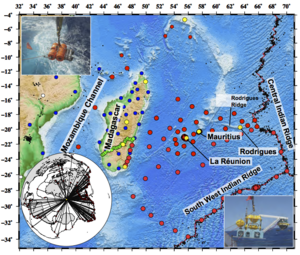
The volcano island of La Réunion is one of the strongest candidates worldwide for a hotspot underlain by a deep, "classical" mantle plume.
RHUM-RUM (Réunion Hotspot and Upper Mantle - Réunions Unterer Mantel) is a French-German passive seismic experiment designed to image an oceanic mantle plume – or lack of plume – from crust to core beneath La Réunion Island, and to understand these results in terms of material, heat flow and plume dynamics. La Réunion hotspot is one of the most active volcanoes in the world, and its hotspot track leads unambiguously to the Deccan Traps of India, one of the largest flood basalt provinces on Earth, which erupted 65 Ma ago. The genesis and the origin at depth of the mantle upwelling and of the hotspot are still very controversial.
In the RHUM-RUM project, 57 German and French ocean-bottom seismometers (OBS) have been deployed in 2012 over an area of 2000 km x 2000 km2 centered on La Réunion Island, using the “Marion Dufresne” and they will be recovered in 2013 by the “Meteor” vessel. The one-year OBS deployment (Oct. 2012 – Oct. 2013) is augmented by terrestrial deployments in the Iles Eparses in the Mozambique Channel, in Madagascar, Seychelles, Mauritius, Rodrigues and La Réunion islands. A significant number of OBS will be also distributed along the Central and South West Indian Ridges to image the lower-mantle beneath the hotspot, but also to provide independent opportunity for the study of these slow to ultra-slow ridges and of possible plume-ridge interactions.
RHUM-RUM aims to characterize the vertically ascending flow in the plume conduit, as well as any lateral flow spreading into the asthenosphere beneath the western Indian Ocean. We want to establish the origin of the heat source that has been fueling this powerful hotspot, by answering the following questions: Is there a direct, isolated conduit into the deepest mantle, which sources its heat and material from the core-mantle boundary? Is there a plume connection to the African superswell at mid-mantle depths? Might the volcanism reflect merely an upper mantle instability? RHUM-RUM also aims at studying the hotspot’s interaction with the neighboring ridges of the Indian Ocean. There is in particular a long-standing hypothesis, not yet examined seismically, that channelized plume flow beneath the aseismic Rodrigues Ridge could feed the Central Indian Ridge at 1000 km distance.
- stations AWI (Alfred Wegener Institut, Bremerhaven) on the Eparses islands (Mozambic Channel),
- 5 stations INSU/SISMOB in South Madagascar,
- 4 stations DEPAS (Deutscher Geräte-Pool für amphibische Seismologie, AWI, Bremerhaven) on Seychelles,
- 12 stations DEPAS on Maurice and Rodrigues,
- 4 stations Université de Muenster à La Réunion,
- 4 stations Université de Bonn à La Réunion,
- 2 stations Géoscience Réunion / IPGP à La Réunion.
Ocean Bottom Seismometers (OBS)
57 ocean bottom seismometers will be droped around Réunion island and Central and South-West Indian Ridges for one year.
- 48 OBS DEPAS
- 9 OBS INSU
Supports
RHUM-RUM project French part is funded by ANR,INSU, OSU-Réunion and TAAF (Terres Australes et Antarctiques Françaises). The German part is funded by DFG (Deutsche Forschungsgemeinschaft).
PRINCIPAL FRENCH INVESTIGATOR
Guilhem Barruol, IPG Paris, CNRS/ Laboratoire Géoscience Réunion, Université de la Réunion.
http://guilhem.barruol%40univ-reunion.frguilhem.barruol[at]univ-reunion.fr
PRINCIPAL GERMAN INVESTIGATOR
Karin Sigloch, Geophysik Group, Ludwig-Maximilians-Universität Munich.
http://sigloch%40geophysik.uni-muenchen.desigloch[at]geophysik.uni-muenchen.de





